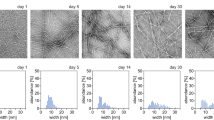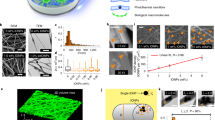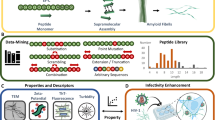Abstract
Inefficient gene transfer and low virion concentrations are common limitations of retroviral transduction1. We and others have previously shown that peptides derived from human semen form amyloid fibrils that boost retroviral gene delivery by promoting virion attachment to the target cells2,3,4,5,6,7,8. However, application of these natural fibril-forming peptides is limited by moderate efficiencies, the high costs of peptide synthesis, and variability in fibril size and formation kinetics. Here, we report the development of nanofibrils that self-assemble in aqueous solution from a 12-residue peptide, termed enhancing factor C (EF-C). These artificial nanofibrils enhance retroviral gene transfer substantially more efficiently than semen-derived fibrils or other transduction enhancers. Moreover, EF-C nanofibrils allow the concentration of retroviral vectors by conventional low-speed centrifugation, and are safe and effective, as assessed in an ex vivo gene transfer study. Our results show that EF-C fibrils comprise a highly versatile, convenient and broadly applicable nanomaterial that holds the potential to significantly facilitate retroviral gene transfer in basic research and clinical applications.
This is a preview of subscription content, access via your institution
Access options
Subscribe to this journal
Receive 12 print issues and online access
$259.00 per year
only $21.58 per issue
Buy this article
- Purchase on Springer Link
- Instant access to full article PDF
Prices may be subject to local taxes which are calculated during checkout





Similar content being viewed by others
References
Mátrai, J., Chuah, M. K. & VandenDriessche, T. Recent advances in lentiviral vector development and applications. Mol. Ther. 18, 477–490 (2010).
Münch, J. et al. Semen-derived amyloid fibrils drastically enhance HIV infection. Cell 131, 1059–1071 (2007).
Roan, N. R. et al. The cationic properties of SEVI underlie its ability to markedly enhance HIV infection. J. Virol. 83, 73–80 (2009).
Kim, K. et al. Semen-mediated enhancement of HIV infection is donor-dependent and correlates with the levels of SEVI. Retrovirology 7, 55 (2010).
Wurm, M. et al. The influence of semen-derived enhancer of virus infection on the efficiency of retroviral gene transfer. J. Gene Med. 12, 137–146 (2010).
Wurm, M. et al. Improved lentiviral gene transfer into human embryonic stem cells grown in co-culture with murine feeder and stroma cells. Biol. Chem. 392, 887–895 (2011).
Roan, N. R. et al. Peptides released by physiological cleavage of semen coagulum proteins form amyloids that enhance HIV infection. Cell Host Microbe 15, 541–550 (2011).
Arnold, F. et al. Naturally occurring fragments from two distinct regions of the prostatic acid phosphatase form amyloidogenic enhancers of HIV infection. J. Virol. 86, 1244–1249 (2012).
Kwong, P. D. et al. Structure of an HIV gp120 envelope glycoprotein in complex with the CD4 receptor and a neutralizing human antibody. Nature 393, 648–659 (1998).
Knowles, T. P. & Buehler, M. J. Nanomechanics of functional and pathological amyloid materials. Nature Nanotech. 6, 469–479 (2011).
Dalhaimer, P., Bates, F. S. & Discher, D. E. Single molecule visualization of stable, stiffness-tunable, flow-conforming worm micelles. Macromolecules 36, 6873–6877 (2003).
Cerf, E. et al. Antiparallel β-sheet: a signature structure of the oligomeric amyloid β-peptide. Biochem. J. 421, 415–423 (2009).
Makin, O. S. & Serpell, L. C. Structures for amyloid fibrils. FEBS J. 272, 5950–5961 (2005).
Shaytan, A. K. et al. Self-assembling nanofibers from thiophene–peptide diblock oligomers: a combined experimental and computer simulations study. ACS Nano 5, 6894–6909 (2011).
Tiscornia, G., Singer, O. & Verma, I. M. Production and purification of lentiviral vectors. Nature Protoc. 1, 241–245 (2006).
Sandrin, V. et al. Lentiviral vectors pseudotyped with a modified RD114 envelope glycoprotein show increased stability in sera and augmented transduction of primary lymphocytes an CD34+ cells derived from human and nonhuman primates. Blood 100, 823–832 (2002).
Schambach, A. et al. Equal potency of gammaretroviral and lentiviral SIN vectors for expression of O6-methylguanine-DNA methyltransferase in hematopoietic cells. Mol. Ther. 13, 391–400 (2006).
Schambach, A. et al. Overcoming promoter competition in packaging cells improves production of self-inactivating retroviral vectors. Gene Ther. 13, 1524–1533 (2006).
Dull, T. et al. A third-generation lentivirus vector with a conditional packaging system. J. Virol. 72, 8463–8471 (1998).
Koeffler, H. P. & Golde, D. W. Human myeloid leukemia cell lines: a review. Blood 56, 344–350 (1980).
Leyva, F. J., Anzinger, J. J., McCoy, J. P. & Kruth, H. S. Evaluation of transduction efficiency in macrophage colony-stimulating factor differentiated human macrophages using HIV-1 based lentiviral vectors. BMC Biotechnol. 11, 13 (2011).
Manning, J. S., Hackett, A. J. & Darby, N. B. Effect of polycations on sensitivity of BALD-3T3 cells to murine leukemia and sarcoma virus infectivity. Appl. Microbiol. 22, 1162–1163 (1971).
Cornetta, K. & Anderson, W. F. Protamine sulfate as an effective alternative to polybrene in retroviral-mediated genetransfer: implications for human gene therapy. J. Virol. Methods 23, 187–194 (1989).
Kaplan, M. M., Wiktor, T. J., Maes, R. F., Campbell, J. B. & Koprowski, H. Effect of polyions on the infectivity of rabies virus in tissue culture: construction of a single-cycle growth curve. J. Virol. 1, 145–151 (1967).
Hanenberg, H. et al. Colocalization of retrovirus and target cells on specific fibronectin fragments increases genetic transduction of mammalian cells. Nature Med. 2, 876–882 (1996).
Hanenberg, H. et al. Optimization of fibronectin-assisted retroviral gene transfer into human CD34+ hematopoietic cells. Hum. Gene Ther. 8, 2193–2206 (1997).
Pollok, K. E. et al. High efficiency gene transfer into normal and adenosine deaminase deficient T lymphocytes is mediated by transduction on recombinant fibronectin fragments. J. Virol. 72, 4882–4892 (1998).
Millington, M., Arndt, A., Boyd, M., Applegate, T. & Shen, S. Towards a clinically relevant lentiviral transduction protocol for primary human CD34 hematopoietic stem/progenitor cells. PLoS ONE 4, e6461 (2009).
Kustikova, O. S. et al. Retroviral vector insertion sites associated with dominant hematopoietic clones mark ‘stemness’ pathways. Blood 109, 1897–1907 (2007).
Knowles, T. P. et al. Role of intermolecular forces in defining material properties of protein nanofibrils. Science 318, 1900–1903 (2007).
Acknowledgements
The authors thank S. Liu for support in the initial phase of the project and D. Krnavek and M. Schlaier for expert technical assistance. The authors also thank W. Mothes for providing the MLV GAG-CFP plasmid, B. Böhm for Bon cells, J. von Einem for HFF cells, the AIDS Research and Reference Program for U87-MG and TZM-bl cells, and N. Landau for CEMx-M7 (CEMx174 5.25 M7) cells. This work was supported by a grant from the German Research Foundation to J.M. Molecular simulations were performed using the resources of Moscow University Supercomputing Center.
Author information
Authors and Affiliations
Contributions
M.Y. generated virus stocks and performed most transductions. C.M. and T.W. assisted in writing the manuscript and were responsible for the structural elucidation of EF-C fibrils. A.K.S., P.G.K. and A.R.K. performed molecular simulations. V.V. and H.G. conducted the ex vivo gene transfer study. C.W.B. and X.S. performed CD analysis. F.A. and D.P. performed coating experiments and measured zeta potentials. O.Z. and J.M. performed Congo Red and ThT assays, S.M.U. was responsible for the analysis of immobilized EF-C by confocal microscopy. D.S. and C.G. performed the fusion assay and flow cytometry assays. P.W. assisted in microscopy. O.L. and T.S. studied the EF-C interaction with virions and cells. J.B. provided retro- and lentiviral vectors and knowhow. H.S. and K.S. isolated and provided human stem cells and performed colony-forming unit assays. L.S. and W.G.F. synthesized and provided peptides. N.R.R. assisted in planning and writing. T.K. analysed AFM data. F.K. and J.M. planned research, analysed data and wrote the manuscript. All authors discussed the results and commented on the manuscript.
Corresponding author
Ethics declarations
Competing interests
M. Yo., F. Ki. and J. Mü. filed for a patent to use EF-C fibrils as tranduction and infection enhancer.
Supplementary information
Supplementary movie S1
Supplementary movie S1 (MOV 17643 kb)
Supplementary movie S2
Supplementary movie S2 (MOV 10073 kb)
Supplementary movie S3
Supplementary movie S3 (AVI 1596 kb)
Supplementary movie S4
Supplementary movie S4 (AVI 1097 kb)
Supplementary movie S5
Supplementary movie S5 (AVI 797 kb)
Rights and permissions
About this article
Cite this article
Yolamanova, M., Meier, C., Shaytan, A. et al. Peptide nanofibrils boost retroviral gene transfer and provide a rapid means for concentrating viruses. Nature Nanotech 8, 130–136 (2013). https://doi.org/10.1038/nnano.2012.248
Received:
Accepted:
Published:
Issue Date:
DOI: https://doi.org/10.1038/nnano.2012.248
This article is cited by
-
gp120-derived amyloidogenic peptides form amyloid fibrils that increase HIV-1 infectivity
Cellular & Molecular Immunology (2024)
-
Cryo-EM structure and polymorphic maturation of a viral transduction enhancing amyloid fibril
Nature Communications (2023)
-
Data-mining unveils structure–property–activity correlation of viral infectivity enhancing self-assembling peptides
Nature Communications (2023)
-
The C-terminal 32-mer fragment of hemoglobin alpha is an amyloidogenic peptide with antimicrobial properties
Cellular and Molecular Life Sciences (2023)
-
Synthetic materials at the forefront of gene delivery
Nature Reviews Chemistry (2018)



